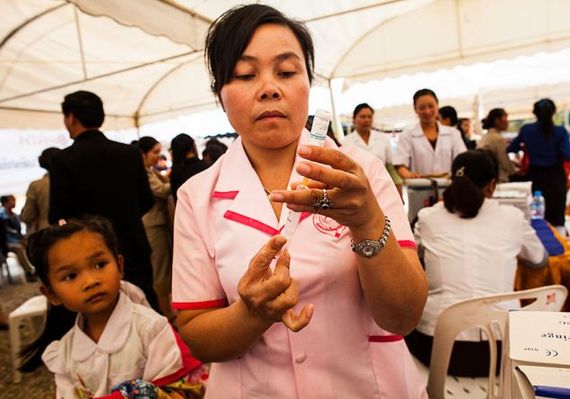When a disease carries a country's name, one might assume that the illness is confined to one geographic area, that one specific place bears its effects. But viruses spread without regard for political boundaries, so this supposition is seldom true.
In the case of Japanese encephalitis (JE), it is false. This disease, colloquially known as "brain fever," threatens three billion people -- predominately poor, rural communities in the Western Pacific and Southeast Asia.
When nearly half the world's population is in danger of contracting a disease, fast action is not only desirable, but critical. Last week, an immunization session held in Vientiane, the capital of Laos, marked the beginning of Gavi, the Vaccine Alliance's support of a campaign that is helping the country reach all of its children with lifesaving vaccines against JE. It also marked a key moment for a new and powerful player in the global vaccine marketplace: China.
 Photo: PATH/Aaron Joel Santos
Photo: PATH/Aaron Joel Santos
Fully appreciating these milestones requires understanding how devastating and deadly JE can be -- and how much work has gone into combatting this virus. Almost 70,000 cases are reported each year, but JE is challenging to diagnose and awareness of the disease remains low, so this number is probably an underestimate.
In Southeast Asia and the Western Pacific, pigs and wading birds, like herons and egrets, host the JE virus. These animals often live in or near rice paddies -- the ideal breeding ground for mosquitoes, which transmit the virus from animals to humans.
JE begins with flu-like symptoms. Approximately one in 250 cases are severe, progressing to brain inflammation that results in death 30 percent of the time. This translates to a conservative estimate of 20,000 deaths each year. Nearly one in three of those who survive JE suffer severe brain damage, which can result in paralysis, frequent seizures, or the inability to speak.
Japanese encephalitis has no cure, and no treatment exists to reverse its symptoms once neurological damage has occurred. A partnership between PATH, a public health NGO and the Chengdu Institute of Biological Products, a leading Chinese vaccine manufacturer, promises to help save lives and prevent long-term disability caused by the disease.
With the knowledge that prevention -- not fumigation -- is the best way to protect infants and children from JE, PATH used a grant from the Bill & Melinda Gates Foundation to find an affordable vaccine. The only vaccine widely available at the time cost upwards of $250 (USD). PATH discovered that China had already developed an inexpensive single-dose vaccine, and had immunized more than 200 million children within its borders.
Recognizing the vaccine's potential, previously unknown outside China, PATH partnered with the Chengdu Institute, the World Health Organization (WHO) and the governments of neighboring Asian countries to run clinical trials, with the goal of getting the vaccine approved for use outside China.
Trials were conducted from 2005 through 2012 in multiple populations. By 2013, eight countries outside of China had received supplies of the vaccine, and were collectively immunizing hundreds of millions of people.
In addition to helping run the tests for quality, safety and efficacy, PATH assisted the Chengdu Institute in designing and building a new manufacturing facility. To help make the vaccine more affordable for low- and middle-income countries, partners worked to establish a public sector price for the vaccine of less than 50 cents per dose -- a huge reduction relative to the cost of similar vaccines sold on the private market.
In October 2013, China's JE vaccine was prequalified by WHO, meaning that the evaluation of its clinical properties and manufacturing process passed muster, and that China, as a country, met WHO indicators for functional vaccine regulation.
This signaled a key victory in the fight against JE, and with its first vaccine prequalified, also heralded China's entrance into the international vaccine market. Given that China ranks first in the world in vaccine production capacity, the country now has the potential to become a major producer of immunizations that developing countries can afford.
Last week's immunization event in Laos represents two significant firsts for Gavi -- its first support of a JE vaccine, and its first support of a vaccine produced by a Chinese manufacturer. Laos began its JE vaccination campaign in 2013, and moving forward, Gavi will fund more than 1.5 million doses to ensure that every child between 12 months and 15 years of age has been vaccinated. Once this catch-up campaign is complete, Laos will take over funding the JE vaccine, and introduce it into its routine immunization program, so that all Laotian children will get the vaccine when they are nine months old.
Japanese encephalitis was so named because the disease was first identified in Japan in the 1870s. Today, thanks to mass immunization campaigns and lifestyle changes, the number of JE cases in Japan has dropped significantly and the name feels like a misnomer. Now that affordable JE vaccines are available to children in need, and countries like China can be part of the global solution, I know we can and will diminish its presence in every country -- so that no nation's name will be connected to this disease.
This post was originally published on Trust.org.
